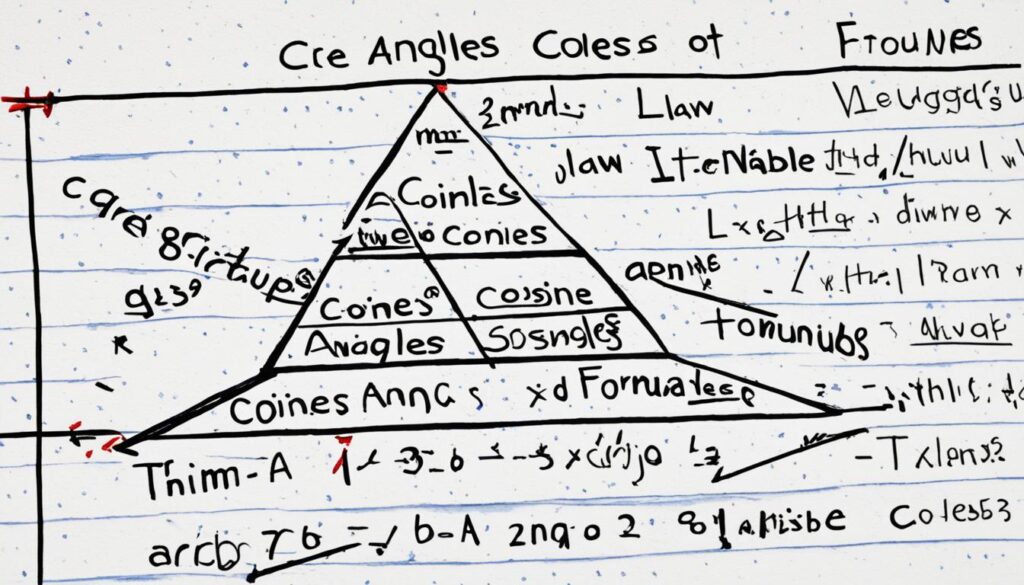Welcome to our comprehensive guide on the law of cosines! If you’ve been struggling with trigonometry or complex triangle calculations, you’re in the right place. In this article, we’ll simplify the concept of the law of cosines, also known as the cosine rule, and show you how to apply it effectively.
Trigonometry can be intimidating, but the law of cosines is a game-changer. With this math formula in your arsenal, you’ll be able to solve intricate angle and side calculations in triangles with ease. Say goodbye to confusion and hello to confidence!
Key Takeaways:
- The law of cosines, also known as the cosine rule, is a crucial concept in trigonometry.
- It simplifies complex angle and side calculations in triangles.
- Understanding the math behind the law of cosines will enhance your problem-solving skills.
- The law of cosines is applicable to various triangle scenarios, including obtuse triangles.
- Real-world applications of the law of cosines span across fields like surveying, navigation, architecture, and physics.
What is the Law of Cosines?
In trigonometry, the law of cosines, also known as the cosine rule, is a fundamental principle that helps us solve complex triangle calculations. This mathematical concept is particularly useful in scenarios where we know the length of all three sides of a triangle, also known as an SSS triangle. Understanding the law of cosines is crucial for accurately solving triangle problems and uncovering valuable insights.
Let’s explore the definition and application of the law of cosines in more detail.
The Law of Cosines Formula
In a triangle with sides of length a, b, and c, the law of cosines states that the square of one side length is equal to the sum of the squares of the other two sides subtracted by twice their product and the cosine of the angle between them.
This can be represented by the formula:
c2 = a2 + b2 – 2ab * cos(C)
Where:
- c represents the side length opposite angle C
- a and b represent the other two side lengths
- C represents the angle between sides a and b
Applying the Law of Cosines
The law of cosines provides us with a powerful tool to solve triangle problems where we have the length of three sides. By using this formula, we can determine missing angles or side lengths, making complex calculations more manageable.
For example, consider a triangle with side lengths of 3 units, 4 units, and 5 units. By applying the law of cosines, we can find the value of the missing angle:
| Side Lengths | Angle Measure |
|---|---|
| 3 units | ? |
| 4 units | |
| 5 units |
Using the law of cosines, we can calculate:
c2 = a2 + b2 – 2ab * cos(C)
52 = 32 + 42 – 2(3)(4) * cos(C)
25 = 9 + 16 – 24 * cos(C)
Simplifying the equation:
cos(C) = (9 + 16 – 25) / (2 * 3 * 4)
After calculating, we find that cos(C) = 0.125. Using inverse cos function (cos-1), we can determine that angle C is approximately 82.82 degrees.
By using the law of cosines, we can solve various triangle problems accurately and efficiently, making trigonometry more approachable and enabling us to explore complex geometrical relationships with ease.
The Math Behind the Law of Cosines
In this section, we will take a closer look at the mathematical foundation of the law of cosines, also known as the cosine rule. By understanding the inner workings of this powerful trigonometric concept, you’ll develop a solid grasp of its applications in solving triangle problems. Let’s explore the math behind the law of cosines.
The Formula
At the core of the law of cosines is a simple yet elegant formula that relates the length of the sides and the angles of a triangle. The formula is as follows:
c^2 = a^2 + b^2 – 2ab cos(C)
Here, c represents the length of the side opposite angle C, while a and b are the lengths of the other two sides. The cosine of angle C comes into play, allowing us to calculate the unknown side or angle in a triangle.
Components and Interactions
Now let’s break down the components of the formula and understand how they interact to determine the unknowns in a triangle. The equation involves squares and products of the side lengths, along with the cosine of the included angle.
- a: The length of side a, adjacent to angle A.
- b: The length of side b, adjacent to angle B.
- c: The length of side c, opposite angle C (the unknown side).
- C: The measure of angle C (the unknown angle).
By manipulating the formula and solving for the desired variable, we can find the missing side or angle in a triangle using the law of cosines.

| Scenario | Known Values | Unknown Value |
|---|---|---|
| SSS Triangle | Sides a, b, c | Angle(s) A, B, or C |
| SAS Triangle | Side a, angle A, and side b | Side c or angle(s) B or C |
| SSA Triangle | Sides a and b, and angle A or B | Side c or angle(s) A or B |
Solving Triangles with the Law of Cosines
In the previous sections, we have discussed the concept of the law of cosines and its mathematical foundation. Now, let’s explore how this powerful mathematical tool can be applied to solve various triangle problems.
One of the primary applications of the law of cosines is finding missing angles in a triangle. By rearranging the formula and solving for the angle, we can determine its measure accurately. This comes in handy when you have two known sides and the included angle, but need to find the third angle to complete the triangle.
Another scenario where the law of cosines proves invaluable is when you need to determine the length of an unknown side. By rearranging the formula and solving for the side length, you can easily find the missing side in a triangle. This is particularly useful when you know the measures of two sides and the included angle, but need to find the length of the third side.
Furthermore, the law of cosines is exceptionally useful in solving problems involving obtuse triangles. When dealing with an obtuse triangle, one of the angles measures greater than 90 degrees. The law of cosines allows us to calculate the measures of the remaining angles and sides accurately, providing a comprehensive solution for obtuse triangles.
Now, let’s take a look at an example to better understand how to apply the law of cosines in triangle problem-solving:
| Example: | An isosceles triangle has two equal sides measuring 8 units each and an included angle of 120 degrees. Calculate the length of the third side. |
|---|---|
| Solution: | Using the law of cosines, we can find the length of the third side. Let’s denote the length of the third side as c. |
| c2 = 82 + 82 – 2 * 8 * 8 * cos(120) | |
| c2 = 64 + 64 – 128 * (-0.5) | |
| c2 = 128 + 64 | |
| c2 = 192 | |
| c = sqrt(192) | |
| c ≈ 13.86 |
By applying the law of cosines, we have found that the length of the third side is approximately 13.86 units.
As you can see, the law of cosines provides a systematic approach to solving triangle problems, especially when dealing with angles, sides, and obtuse triangles. By mastering this powerful trigonometric concept, you’ll be able to tackle complex triangle calculations with ease and precision.
Real-World Applications of the Law of Cosines
Now that we have explored the fundamental concepts of the law of cosines, let’s delve into its practical applications in real-world scenarios. This mathematical concept, rooted in trigonometry, finds its usefulness in various fields, including surveying, navigation, architecture, and physics. Understanding how the law of cosines can be applied in these contexts will deepen your appreciation for its utility.
Surveying and Mapping
Surveyors rely on the law of cosines to accurately measure distances and angles between points on the Earth’s surface. By using this trigonometric formula, they can determine the precise location and shape of land features, ensuring accurate maps and boundary lines.
Navigation and Astronomy
In navigation, the law of cosines is essential for solving problems related to celestial navigation and determining the position of a vessel at sea. By measuring celestial angles and using the law of cosines, navigators can calculate distances and plot precise courses.
Architecture and Engineering
The law of cosines plays a crucial role in architecture and engineering when designing structures and determining angles and distances. From calculating roof pitches to establishing the stability of bridges, this math formula enables architects and engineers to ensure the strength, stability, and safety of their designs.
Physics and Mechanics
In physics, the law of cosines is often used to analyze forces and motion in complex systems. It helps physicists calculate the angles and distances involved in various physical phenomena, such as projectile motion and the behavior of objects on an inclined plane.
“The law of cosines is an invaluable tool in solving real-world problems across multiple disciplines. Its application in fields like surveying, navigation, architecture, and physics underscores its versatility and significance.” – Dr. Sarah Thompson, Mathematician
Real-World Applications of the Law of Cosines
| Field | Application |
|---|---|
| Surveying | Accurate measurement of distances and angles on the Earth’s surface |
| Navigation | Precise determination of vessel position and course at sea |
| Architecture | Calculation of angles and distances for structures and designs |
| Engineering | Analysis of forces and stability in various engineering projects |
| Physics | Characterization of angles and distances in physical phenomena |
As we can see from the table and examples above, the law of cosines finds practical application in diverse fields, enabling professionals to solve complex real-world problems. Its versatility and relevance make it an invaluable tool for anyone seeking to navigate the intricacies of trigonometry and its mathematical applications.
Conclusion
Throughout this article, we have explored the key concepts surrounding the law of cosines, a fundamental tool in trigonometry. By understanding and applying this math law, we gain the ability to simplify complex calculations and uncover the secrets of triangles.
The law of cosines plays a crucial role in solving angle and side calculations, particularly in cases where we have the length of three sides or an SSS triangle. Its formula, rooted in trigonometry, allows us to calculate angles and sides accurately, providing a solid foundation for triangle problem-solving.
Mastering the law of cosines gives us a valuable skill that can be applied across various fields and scenarios. From surveying to navigation, architecture to physics, this mathematical concept finds practical applications in the real world. By understanding and leveraging the power of the law of cosines, we unlock new possibilities and enhance our problem-solving capabilities.
In conclusion, the law of cosines is an essential math law in trigonometry, enabling us to simplify complex triangle calculations. By delving into its concepts, understanding the math behind it, and exploring its applications, we have gained valuable insights into the power of this mathematical tool. So, let’s embrace the law of cosines and continue our exploration of the fascinating world of trigonometry and mathematics.
FAQ
What is the law of cosines?
The law of cosines, also known as the cosine rule, is a math formula used in trigonometry to solve complex angle and side calculations in triangles. It provides a method for finding the length of a side or measure of an angle when the lengths of the other two sides and the included angle are known.
How is the law of cosines applied to triangle calculations?
The law of cosines is particularly useful in solving triangle problems when we have the length of three sides, also known as an SSS triangle. By inputting the lengths of the sides into the formula, we can calculate the unknown angles or sides of the triangle.
Could you explain the mathematical foundation of the law of cosines?
Certainly! The law of cosines can be expressed using the following formula: c² = a² + b² – 2ab * cos(C). Here, “c” represents the length of the side opposite the angle “C,” while “a” and “b” are the lengths of the other two sides. By knowing these values, we can calculate the angle “C” or the length of side “c.”
How can the law of cosines be used to solve triangles?
The law of cosines allows us to solve various triangle scenarios. It helps us find missing angles by calculating the inverse cosine of the obtained value, and it also enables us to determine unknown side lengths. Additionally, the law of cosines can be applied to solve problems involving obtuse triangles, providing a versatile tool for triangle calculations.
What are some real-world applications of the law of cosines?
The law of cosines finds practical applications in fields such as surveying, navigation, architecture, and physics. It allows surveyors to calculate distances between points by using known side lengths and angles. In navigation, it aids in determining a ship’s position using angles and side lengths. Architects can use the law of cosines to determine the lengths of diagonals in a structure, ensuring stability. Physicists utilize the law of cosines in analyzing forces acting on objects at various angles.










